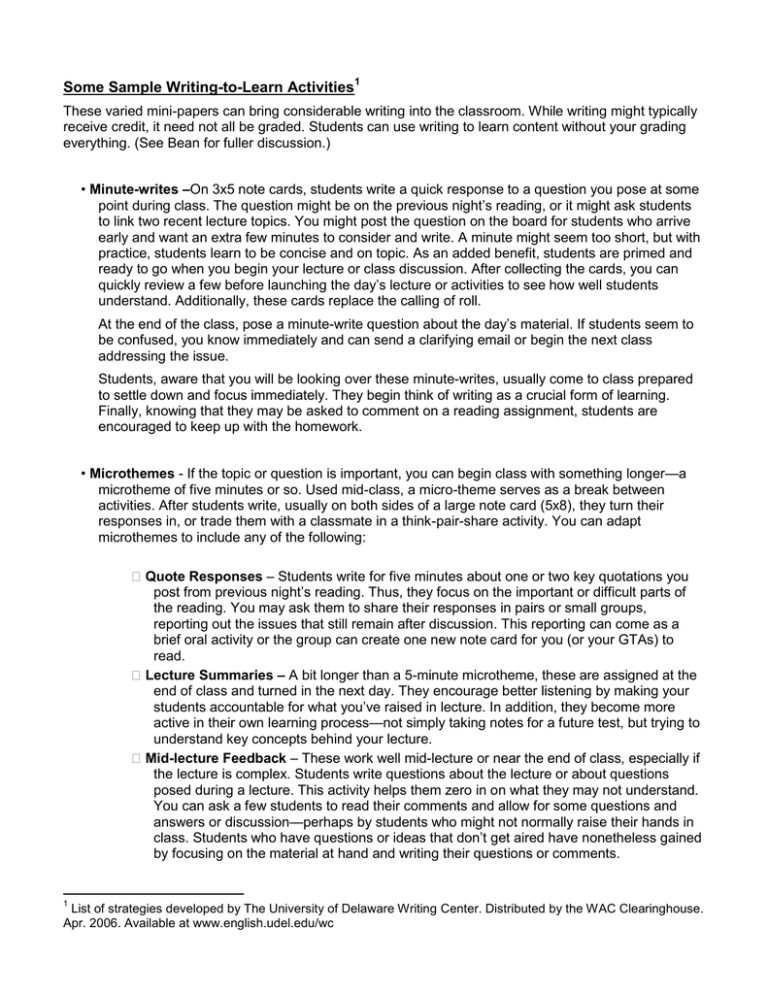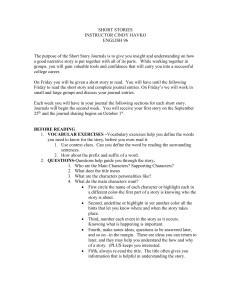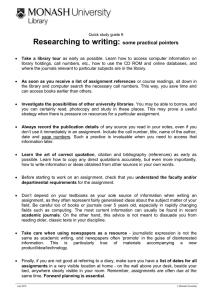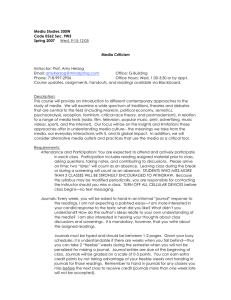Some Sample Writing-to-Learn Activities
advertisement

Some Sample Writing-to-Learn Activities1 These varied mini-papers can bring considerable writing into the classroom. While writing might typically receive credit, it need not all be graded. Students can use writing to learn content without your grading everything. (See Bean for fuller discussion.) • Minute-writes –On 3x5 note cards, students write a quick response to a question you pose at some point during class. The question might be on the previous night’s reading, or it might ask students to link two recent lecture topics. You might post the question on the board for students who arrive early and want an extra few minutes to consider and write. A minute might seem too short, but with practice, students learn to be concise and on topic. As an added benefit, students are primed and ready to go when you begin your lecture or class discussion. After collecting the cards, you can quickly review a few before launching the day’s lecture or activities to see how well students understand. Additionally, these cards replace the calling of roll. At the end of the class, pose a minute-write question about the day’s material. If students seem to be confused, you know immediately and can send a clarifying email or begin the next class addressing the issue. Students, aware that you will be looking over these minute-writes, usually come to class prepared to settle down and focus immediately. They begin think of writing as a crucial form of learning. Finally, knowing that they may be asked to comment on a reading assignment, students are encouraged to keep up with the homework. • Microthemes - If the topic or question is important, you can begin class with something longer—a microtheme of five minutes or so. Used mid-class, a micro-theme serves as a break between activities. After students write, usually on both sides of a large note card (5x8), they turn their responses in, or trade them with a classmate in a think-pair-share activity. You can adapt microthemes to include any of the following: � Quote Responses – Students write for five minutes about one or two key quotations you post from previous night’s reading. Thus, they focus on the important or difficult parts of the reading. You may ask them to share their responses in pairs or small groups, reporting out the issues that still remain after discussion. This reporting can come as a brief oral activity or the group can create one new note card for you (or your GTAs) to read. � Lecture Summaries – A bit longer than a 5-minute microtheme, these are assigned at the end of class and turned in the next day. They encourage better listening by making your students accountable for what you’ve raised in lecture. In addition, they become more active in their own learning process—not simply taking notes for a future test, but trying to understand key concepts behind your lecture. � Mid-lecture Feedback – These work well mid-lecture or near the end of class, especially if the lecture is complex. Students write questions about the lecture or about questions posed during a lecture. This activity helps them zero in on what they may not understand. You can ask a few students to read their comments and allow for some questions and answers or discussion—perhaps by students who might not normally raise their hands in class. Students who have questions or ideas that don’t get aired have nonetheless gained by focusing on the material at hand and writing their questions or comments. 1 List of strategies developed by The University of Delaware Writing Center. Distributed by the WAC Clearinghouse. Apr. 2006. Available at www.english.udel.edu/wc • Doubting/Believing Game - Engaging in Peter Elbow’s Doubting/Believing game, students explore two sides of an issue. First, students earnestly doubt a proposition and then summarize their conclusions in writing. Next, they earnestly believe the same position, again summarizing their best reasons or evidence. Doubts and beliefs are then shared in pairs or small groups. • Guided Journals or Learning Logs –In ongoing journals, students write summaries of concepts raised in class. Log entries may be metacognitive (where students reflect on their own learning process). In these, students respond to your prompts such as What’s been difficult to understand? What problems are most interesting? What areas do you need to review? The idea is not for students to write sparkling prose, but for them to probe for ideas and reflect productively. Have students keep their journals in a three-ring binder on loose-leaf paper, then, they turn in only the paper. You can also invite email submissions. You can’t read all the journals, but you can collect pages periodically or from a random number of students each time. Silvia and Hom at UC Davis suggest Journal Roulette. Students are assigned to one of 12 groups. On a given day, the instructor rolls the dice and collects journals from the group whose number has been rolled. Grading journals can be simple – use a checkmark system and write one or two comments prompted by what the student has written: I think your ideas on wind dynamics are a bit unusual, but actually they are supported by some research. You might look at Hartley and Korach. Such response show your students that you have read the entries and are engaged, even if briefly, with them. Such personal responses are important and valued by students in large classes. • Reading Journals – You can require reading journal entries as homework, assigning two or three responses a week to the textbook or other readings. You need not collect all of them weekly, but do collect them regularly and give credit for effort. Students know you are reading their work and become more current with the out-of-class reading. Reading journals work best when you generate questions for students. Your prompts should help students go beyond summary early in the semester to higher-order thinking skills such as analysis or synthesis later in the semester. Summarize the three main points of each of this week’s readings, focusing on data embedded in graphs and tables. Does some data weaken the authors’ main points? Our readings argue two sides of globalization. Can you argue a third position? • Question/Comment Box - Keep a shoebox where students can anonymously put note cards with questions at the end of class. Questions can be about lecture content, concerns about how material is covered in class, or outside reading. While their comments are extremely short, students learn that their written comments or questions must be clear in order to be understood.





